Is Embodied Energy a Better Starting Point for Solving Energy Security Issues?—Based on an Overview of Embodied Energy-Related Research
Abstract
1. Introduction
- (1)
- A comprehensive understanding of embodied energy and development of relevant research;
- (2)
- An analysis of why and how embodied energy can benefit energy security issues;
- (3)
- Future improvement and research directions.
2. Background and Development
2.1. Definition and Characteristics of Embodied Energy
2.1.1. Definition of Embodied Energy
2.1.2. Characteristics of Embodied Energy
Comprehensiveness
Flowability
Separability
Scalability
2.2. Development of Relevant Embodied Energy Studies
2.2.1. Information on Relevant Embodied Energy Literature
Literature Selection Criteria and Procedure
Annual Volume Analysis
Journal Distribution
2.2.2. Research Field and Trend Analysis
3. Review Results
3.1. Calculation Methods of Embodied Energy
3.2. A New Perspective of Demand and Consumption of Energy
3.3. Embodied Energy and Energy Security
4. Discussion
4.1. How to Solve the Problem of Timeliness and Authority of Data?
4.2. How to Develop More Practical Recommendations or Plans for Energy Policy-Making to Improve Energy Security?
4.3. To What Extent Can Help Solve Energy Security Issues?
5. Conclusions
Author Contributions
Funding
Conflicts of Interest
References
- Chow, J. Energy Resources and Global Development. Science 2003, 302, 1528–1531. [Google Scholar] [CrossRef] [PubMed]
- Bortolamedi, M. Accounting for hidden energy dependency: The impact of energy embodied in traded goods on cross-country energy security assessments. Energy 2015, 93, 1361–1372. [Google Scholar] [CrossRef]
- Popescu, G.H.; Mieila, M.; Nica, E.; Andrei, J.V. The emergence of the effects and determinants of the energy paradigm changes on European Union economy. Renew. Sustain. Energy Rev. 2018, 81, 768–774. [Google Scholar] [CrossRef]
- World Energy Outlook 2018. Available online: https://www.iea.org/weo2018/ (accessed on 2 April 2019).
- BP Statistical Review of World Energy. Available online: https://www.bp.com/content/dam/bp/business-sites/en/global/corporate/pdfs/energy-economics/statistical-review/bp-stats-review-2019-full-report.pdf (accessed on 26 June 2019).
- Turton, H.; Barreto, L. Long-term security of energy supply and climate change. Energy Policy 2006, 34, 2232–2250. [Google Scholar] [CrossRef]
- Chow, G.C. China’s Energy and Environmental Problems and Policies. Asia Pac. J. Account. Econ. 2008, 15, 57–70. [Google Scholar] [CrossRef][Green Version]
- Qian, X.; Liu, C.; Jiang, X.; Xu, J. Overview of international oil and gas industry developments in 2017 and outlook for 2018. Int. Pet. Econ. 2018, 26, 32–38. [Google Scholar]
- Barrett, M.; Lowe, R.; Oreszczyn, T.; Steadman, P.; Oreszczyn, T. How to support growth with less energy. Energy Policy 2008, 36, 4592–4599. [Google Scholar] [CrossRef]
- Bashmakov, I.; Myshak, A. Russian energy efficiency accounting system. Energy Effic. 2014, 7, 743–759. [Google Scholar] [CrossRef]
- Erdal, L.; Pektaş, A.O.; Ozkan, O.; Özkan, F. Security of energy supply in Japan: A key strategy and solutions. Int. J. Glob. Warm. 2015, 7, 128. [Google Scholar] [CrossRef]
- Aguayo, F.; Gallagher, K.P. Economic reform, energy, and development: The case of Mexican manufacturing. Energy Policy 2005, 33, 829–837. [Google Scholar] [CrossRef]
- Leung, G.C. China’s oil use, 1990–2008. Energy Policy 2010, 38, 932–944. [Google Scholar] [CrossRef]
- Costanza, R. Embodied Energy and Economic Valuation. Science 1980, 210, 1219–1224. [Google Scholar] [CrossRef] [PubMed]
- An, Q.; An, H.; Wang, L.; Gao, X.; Lv, N. Analysis of embodied exergy flow between Chinese industries based on network theory. Ecol. Model. 2015, 318, 26–35. [Google Scholar] [CrossRef]
- Tang, X.; Snowden, S.; Höök, M. Analysis of energy embodied in the international trade of UK. Energy Policy 2013, 57, 418–428. [Google Scholar] [CrossRef]
- Chen, B.; Li, J.; Wu, X.; Han, M.; Zeng, L.; Li, Z.; Chen, G. Global energy flows embodied in international trade: A combination of environmentally extended input-output analysis and complex network analysis. Appl. Energy 2018, 210, 98–107. [Google Scholar] [CrossRef]
- Liu, H.; Xi, Y.; Guo, J.; Li, X. Energy embodied in the international trade of China: An energy input–output analysis. Energy Policy 2010, 38, 3957–3964. [Google Scholar] [CrossRef]
- Sun, C.; Ma, T.; Xu, M. Exploring the prospects of cooperation in the manufacturing industries between India and China: A perspective of embodied energy in India-China trade. Energy Policy 2018, 113, 643–650. [Google Scholar] [CrossRef]
- Yang, R.; Long, R.; Yue, T.; Shi, H. Calculation of embodied energy in Sino-USA trade: 1997–2011. Energy Policy 2014, 72, 110–119. [Google Scholar] [CrossRef]
- Zhang, B.; Chen, Z.; Xia, X.; Xu, X.; Chen, Y. The impact of domestic trade on China’s regional energy uses: A multi-regional input–output modeling. Energy Policy 2013, 63, 1169–1181. [Google Scholar] [CrossRef]
- Shi, J.; Li, H.; Guan, J.; Sun, X.; Guan, Q.; Liu, X. Evolutionary features of global embodied energy flow between sectors: A complex network approach. Energy 2017, 140, 395–405. [Google Scholar] [CrossRef]
- Dixit, M.K. Life cycle recurrent embodied energy calculation of buildings: A review. J. Clean. Prod. 2018. [Google Scholar] [CrossRef]
- Dixit, M.K.; Culp, C.H.; Fernandez-Solis, J.L. System boundary for embodied energy in buildings: A conceptual model for definition. Renew. Sustain. Energy Rev. 2013, 21, 153–164. [Google Scholar] [CrossRef]
- Wu, X.; Chen, G. Coal use embodied in globalized world economy: From source to sink through supply chain. Renew. Sustain. Energy Rev. 2018, 81, 978–993. [Google Scholar] [CrossRef]
- Tang, X.; Zhang, B.; Feng, L.; Snowden, S.; Höök, M. Net oil exports embodied in China’s international trade: An input–output analysis. Energy 2012, 48, 464–471. [Google Scholar] [CrossRef]
- Cortés-Borda, D.; Guillén-Gosálbez, G.; Jiménez, L. Solar energy embodied in international trade of goods and services: A multi-regional input–output approach. Energy 2015, 82, 578–588. [Google Scholar] [CrossRef]
- Cortés-Borda, D.; Guillén-Gosálbez, G.; Jiménez, L. Assessment of nuclear energy embodied in international trade following a world multi-regional input–output approach. Energy 2015, 91, 91–101. [Google Scholar] [CrossRef]
- Wiedmann, T.; Lenzen, M.; Turner, K.; Barrett, J. Examining the global environmental impact of regional consumption activities—Part 2: Review of input–output models for the assessment of environmental impacts embodied in trade. Ecol. Econ. 2007, 61, 15–26. [Google Scholar] [CrossRef]
- Lindner, S.; Guan, D. A Hybrid-Unit Energy Input-Output Model to Evaluate Embodied Energy and Life Cycle Emissions for China’s Economy. J. Ind. Ecol. 2014, 18, 201–211. [Google Scholar] [CrossRef]
- Chen, Z.-M.; Chen, G.; Chen, G.; Chen, G. Demand-driven energy requirement of world economy 2007: A multi-region input–output network simulation. Commun. Nonlinear Sci. Numer. Simul. 2013, 18, 1757–1774. [Google Scholar] [CrossRef]
- Wu, X.; Xia, X.; Chen, G.; Wu, X.; Chen, B. Embodied energy analysis for coal-based power generation system-highlighting the role of indirect energy cost. Appl. Energy 2016, 184, 936–950. [Google Scholar] [CrossRef]
- Sun, X.; An, H.; Gao, X.; Jia, X.; Liu, X. Indirect energy flow between industrial sectors in China: A complex network approach. Energy 2016, 94, 195–205. [Google Scholar] [CrossRef]
- Shao, L.; Chen, G.; Chen, G. Embodied water accounting and renewability assessment for ecological wastewater treatment. J. Clean. Prod. 2016, 112, 4628–4635. [Google Scholar] [CrossRef]
- Kara, S.; Ibbotson, S. Embodied energy of manufacturing supply chains. CIRP J. Manuf. Sci. Technol. 2011, 4, 317–323. [Google Scholar] [CrossRef]
- Machado, G.; Schaeffer, R.; Worrell, E. Energy and carbon embodied in the international trade of Brazil: An input–output approach. Ecol. Econ. 2001, 39, 409–424. [Google Scholar] [CrossRef]
- Monahan, J.; Powell, J. An embodied carbon and energy analysis of modern methods of construction in housing: A case study using a lifecycle assessment framework. Energy Build. 2011, 43, 179–188. [Google Scholar] [CrossRef]
- Matthews, H.S. Embodied Environmental Emissions in U.S. International Trade, 1997−2004. Environ. Sci. Technol. 2007, 41, 4875–4881. [Google Scholar] [CrossRef]
- Davis, S.J.; Peters, G.P.; Caldeira, K. The supply chain of CO2 emissions. Proc. Natl. Acad. Sci. USA 2011, 108, 18554–18559. [Google Scholar] [CrossRef]
- Wiedmann, T. A review of recent multi-region input–output models used for consumption-based emission and resource accounting. Ecol. Econ. 2009, 69, 211–222. [Google Scholar] [CrossRef]
- Davis, S.J.; Caldeira, K. Consumption-based accounting of CO2 emissions. Proc. Natl. Acad. Sci. USA 2010, 107, 5687–5692. [Google Scholar] [CrossRef]
- Merigó, J.M.; Miranda, J.; Modak, N.M.; Boustras, G.; De La Sotta, C. Forty years of Safety Science: A bibliometric overview. Saf. Sci. 2019, 115, 66–88. [Google Scholar] [CrossRef]
- Norris, M.; Oppenheim, C. Comparing alternatives to the Web of Science for coverage of the social sciences’ literature. J. Inf. 2007, 1, 161–169. [Google Scholar] [CrossRef]
- Chen, C.M. Searching for intellectual turning points: Progressive knowledge domain visualization. Proc. Natl. Acad. Sci. USA 2004, 101, 5303–5310. [Google Scholar] [CrossRef]
- Bordigoni, M.; Hita, A.; Le Blanc, G. Role of embodied energy in the European manufacturing industry: Application to short-term impacts of a carbon tax. Energy Policy 2012, 43, 335–350. [Google Scholar] [CrossRef]
- Leontief, W. Environmental Repercussions and the Economic Structure: An Input-Output Approach. Rev. Econ. Stat. 1970, 52, 262. [Google Scholar] [CrossRef]
- Lin, L.; Fan, Y.; Xu, M.; Sun, C. A Decomposition Analysis of Embodied Energy Consumption in China’s Construction Industry. Sustainability 2017, 9, 1583. [Google Scholar] [CrossRef]
- Yunfeng, Y.; Laike, Y. China’s foreign trade and climate change: A case study of CO2 emissions. Energy Policy 2010, 38, 350–356. [Google Scholar] [CrossRef]
- Xu, M.; Li, R.; Crittenden, J.C.; Chen, Y. CO2 emissions embodied in China’s exports from 2002 to 2008: A structural decomposition analysis. Energy Policy 2011, 39, 7381–7388. [Google Scholar] [CrossRef]
- Minx, J.C.; Baiocchi, G.; Peters, G.P.; Weber, C.L.; Guan, D.; Hubacek, K. A “Carbonizing Dragon”: China’s Fast Growing CO2Emissions Revisited. Environ. Sci. Technol. 2011, 45, 9144–9153. [Google Scholar] [CrossRef]
- Qi, T.; Winchester, N.; Karplus, V.J.; Zhang, X. Will economic restructuring in China reduce trade-embodied CO2 emissions? Energy Econ. 2014, 42, 204–212. [Google Scholar] [CrossRef]
- Atkinson, G.; Hamilton, K.; Ruta, G.; Van Der Mensbrugghe, D. Trade in ‘virtual carbon’: Empirical results and implications for policy. Glob. Environ. Chang. 2011, 21, 563–574. [Google Scholar] [CrossRef]
- Hertwich, E.G.; Peters, G.P. Carbon footprint of nations: A global, trade-linked analysis. Environ. Sci. Technol. 2009, 43, 6414–6420. [Google Scholar] [CrossRef]
- Zhang, B.; Qiao, H.; Chen, Z.; Chen, B. Growth in embodied energy transfers via China’s domestic trade: Evidence from multi-regional input–output analysis. Appl. Energy 2016, 184, 1093–1105. [Google Scholar] [CrossRef]
- Gao, C.; Su, B.; Sun, M.; Zhang, X.; Zhang, Z. Interprovincial transfer of embodied primary energy in China: A complex network approach. Appl. Energy 2018, 215, 792–807. [Google Scholar] [CrossRef]
- Liu, Z.; Geng, Y.; Lindner, S.; Zhao, H.; Fujita, T.; Guan, D. Embodied energy use in China’s industrial sectors. Energy Policy 2012, 49, 751–758. [Google Scholar] [CrossRef]
- Tao, F.; Xu, Z.; Duncan, A.A.; Xia, X.; Wu, X.; Li, J. Driving forces of energy embodied in China-EU manufacturing trade from 1995 to 2011. Resour. Conserv. Recycl. 2018, 136, 324–334. [Google Scholar] [CrossRef]
- Pincetl, S.; Bunje, P.; Holmes, T. An expanded urban metabolism method: Toward a systems approach for assessing urban energy processes and causes. Landsc. Urban Plan. 2012, 107, 193–202. [Google Scholar] [CrossRef]
- Sato, M.; Kharrazi, A.; Nakayama, H.; Kraines, S.; Yarime, M. Quantifying the supplier-portfolio diversity of embodied energy: Strategic implications for strengthening energy resilience. Energy Policy 2017, 105, 41–52. [Google Scholar] [CrossRef]
- Li, J.; Xia, X.; Chen, G.; Alsaedi, A.; Hayat, T. Optimal embodied energy abatement strategy for Beijing economy: Based on a three-scale input-output analysis. Renew. Sustain. Energy Rev. 2016, 53, 1602–1610. [Google Scholar] [CrossRef]
- Cui, L.-B.; Peng, P.; Zhu, L. Embodied energy, export policy adjustment and China’s sustainable development: A multi-regional input-output analysis. Energy 2015, 82, 457–467. [Google Scholar] [CrossRef]
- Wang, X.; Yao, M.; Li, J.; Ge, J.; Wei, W.; Wu, B.; Zhang, M. Global embodied rare earths flows and the outflow paths of China’s embodied rare earths: Combining multi-regional input-output analysis with the complex network approach. J. Clean. Prod. 2019, 216, 435–445. [Google Scholar] [CrossRef]
- Jiang, M.; An, H.; Guan, Q.; Sun, X. Global embodied mineral flow between industrial sectors: A network perspective. Resour. Policy 2018, 58, 192–201. [Google Scholar] [CrossRef]
- Tang, M.; Hong, J.; Liu, G.; Shen, G.Q. Exploring energy flows embodied in China’s economy from the regional and sectoral perspectives via combination of multi-regional input–output analysis and a complex network approach. Energy 2019, 170, 1191–1201. [Google Scholar] [CrossRef]
- Feng, Z.; Zhou, W.; Ming, Q. Embodied Energy Flow Patterns of the Internal and External Industries of Manufacturing in China. Sustainability 2019, 11, 438. [Google Scholar] [CrossRef]
- Fay, R.; Treloar, G.; Iyer-Raniga, U. Life-cycle energy analysis of buildings: A case study. Build. Res. Inf. 2000, 28, 31–41. [Google Scholar] [CrossRef]
- Bribián, I.Z.; Capilla, A.V.; Usón, A.A. Life cycle assessment of building materials: Comparative analysis of energy and environmental impacts and evaluation of the eco-efficiency improvement potential. Build. Environ. 2011, 46, 1133–1140. [Google Scholar] [CrossRef]
- Held, R.B.; Zhang, Q.; Mihelcic, J.R. Quantification of human and embodied energy of improved water provided by source and household interventions. J. Clean. Prod. 2013, 60, 83–92. [Google Scholar] [CrossRef]
- Suh, S.; Lenzen, M.; Treloar, G.J.; Hondo, H.; Horvath, A.; Huppes, G.; Jolliet, O.; Klann, U.; Krewitt, W.; Moriguchi, Y.; et al. System Boundary Selection in Life-Cycle Inventories Using Hybrid Approaches. Environ. Sci. Technol. 2004, 38, 657–664. [Google Scholar] [CrossRef]
- Asdrubali, F.; Baldassarri, C.; Fthenakis, V. Life cycle analysis in the construction sector: Guiding the optimization of conventional Italian buildings. Energy Build. 2013, 64, 73–89. [Google Scholar] [CrossRef]
- Basbagill, J.; Flager, F.; Lepech, M.; Fischer, M. Application of life-cycle assessment to early stage building design for reduced embodied environmental impacts. Build. Environ. 2013, 60, 81–92. [Google Scholar] [CrossRef]
- Hashemi, A.; Cruickshank, H.; Cheshmehzangi, A. Environmental Impacts and Embodied Energy of Construction Methods and Materials in Low-Income Tropical Housing. Sustainability 2015, 7, 7866–7883. [Google Scholar] [CrossRef]
- Chastas, P.; Theodosiou, T.; Bikas, D. Embodied energy in residential buildings-towards the nearly zero energy building: A literature review. Build. Environ. 2016, 105, 267–282. [Google Scholar] [CrossRef]
- Lenzen, M. Primary energy and greenhouse gases embodied in Australian final consumption: An input-output analysis. Energy Policy 1998, 26, 495–506. [Google Scholar] [CrossRef]
- Hong, J.; Shen, G.Q.; Guo, S.; Xue, F.; Zheng, W. Energy use embodied in China׳s construction industry: A multi-regional input–output analysis. Renew. Sustain. Energy Rev. 2016, 53, 1303–1312. [Google Scholar] [CrossRef]
- Tang, X.; Jin, Y.; McLellan, B.C.; Wang, J.; Li, S. China’s coal consumption declining—Impermanent or permanent? Resour. Conserv. Recycl. 2018, 129, 307–313. [Google Scholar] [CrossRef]
- Kruyt, B.; Van Vuuren, D.; De Vries, H.; Groenenberg, H.; Van Vuuren, D. Indicators for energy security. Energy Policy 2009, 37, 2166–2181. [Google Scholar] [CrossRef]
- Li, J.; Chen, G.; Wu, X.; Hayat, T.; Alsaedi, A.; Ahmad, B.; Chen, G. Embodied energy assessment for Macao׳s external trade. Renew. Sustain. Energy Rev. 2014, 34, 642–653. [Google Scholar] [CrossRef]
- Moreau, V.; Vuille, F. Decoupling energy use and economic growth: Counter evidence from structural effects and embodied energy in trade. Appl. Energy 2018, 215, 54–62. [Google Scholar] [CrossRef]
- Uluer, M.U.; Unver, H.O.; Gok, G.; Fescioglu-Unver, N.; Kilic, S.E. A framework for energy reduction in manufacturing process chains (E-MPC) and a case study from the Turkish household appliance industry. J. Clean. Prod. 2016, 112, 3342–3360. [Google Scholar] [CrossRef]
- Mo, W.; Nasiri, F.; Eckelman, M.J.; Zhang, Q.; Zimmerman, J.B. Measuring the Embodied Energy in Drinking Water Supply Systems: A Case Study in The Great Lakes Region. Environ. Sci. Technol. 2010, 44, 9516–9521. [Google Scholar] [CrossRef]
- Goe, M.; Gaustad, G. Identifying critical materials for photovoltaics in the US: A multi-metric approach. Appl. Energy 2014, 123, 387–396. [Google Scholar] [CrossRef]
- Proskuryakova, L. Updating energy security and environmental policy: Energy security theories revisited. J. Environ. Manag. 2018, 223, 203–214. [Google Scholar] [CrossRef]
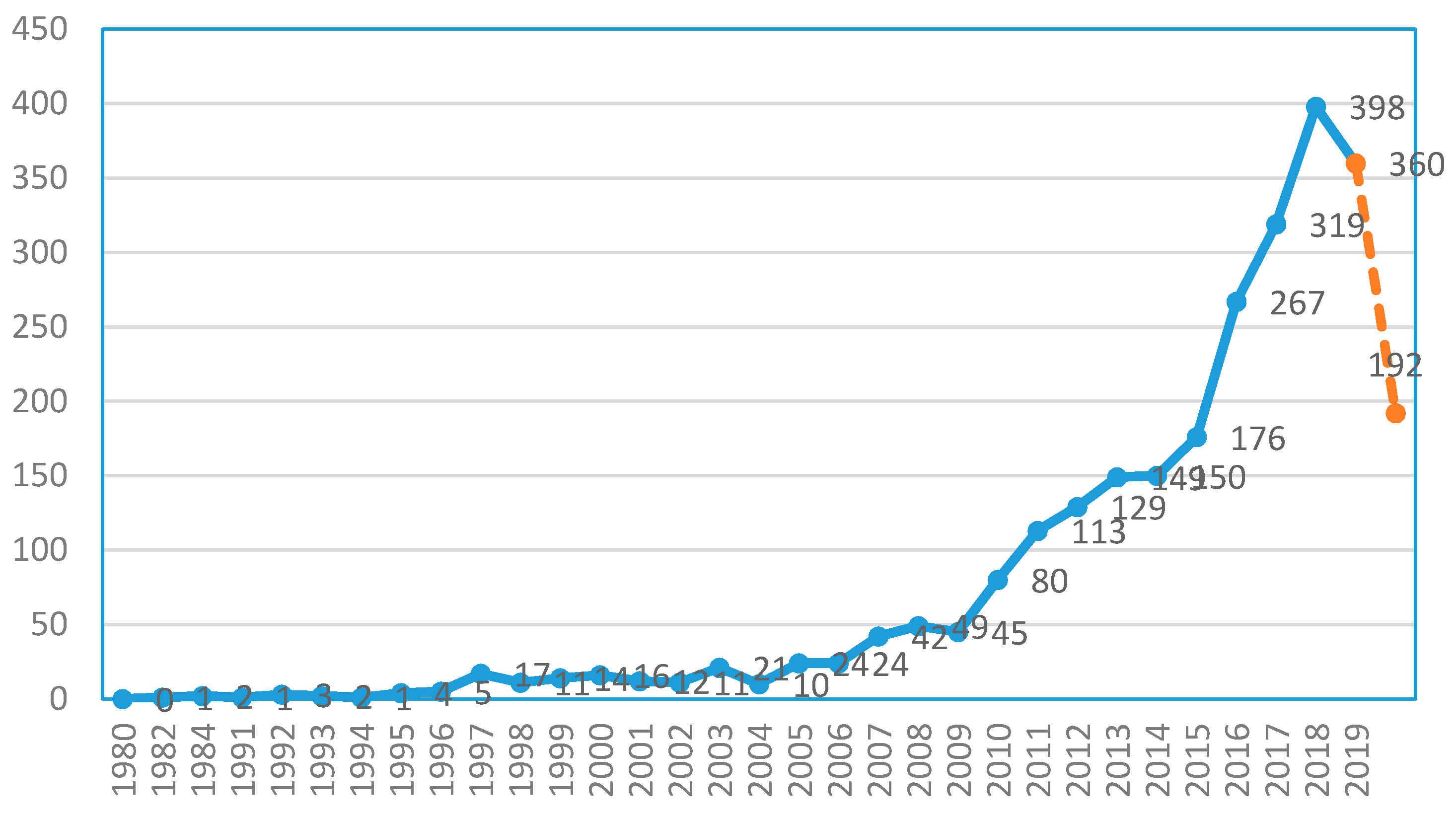
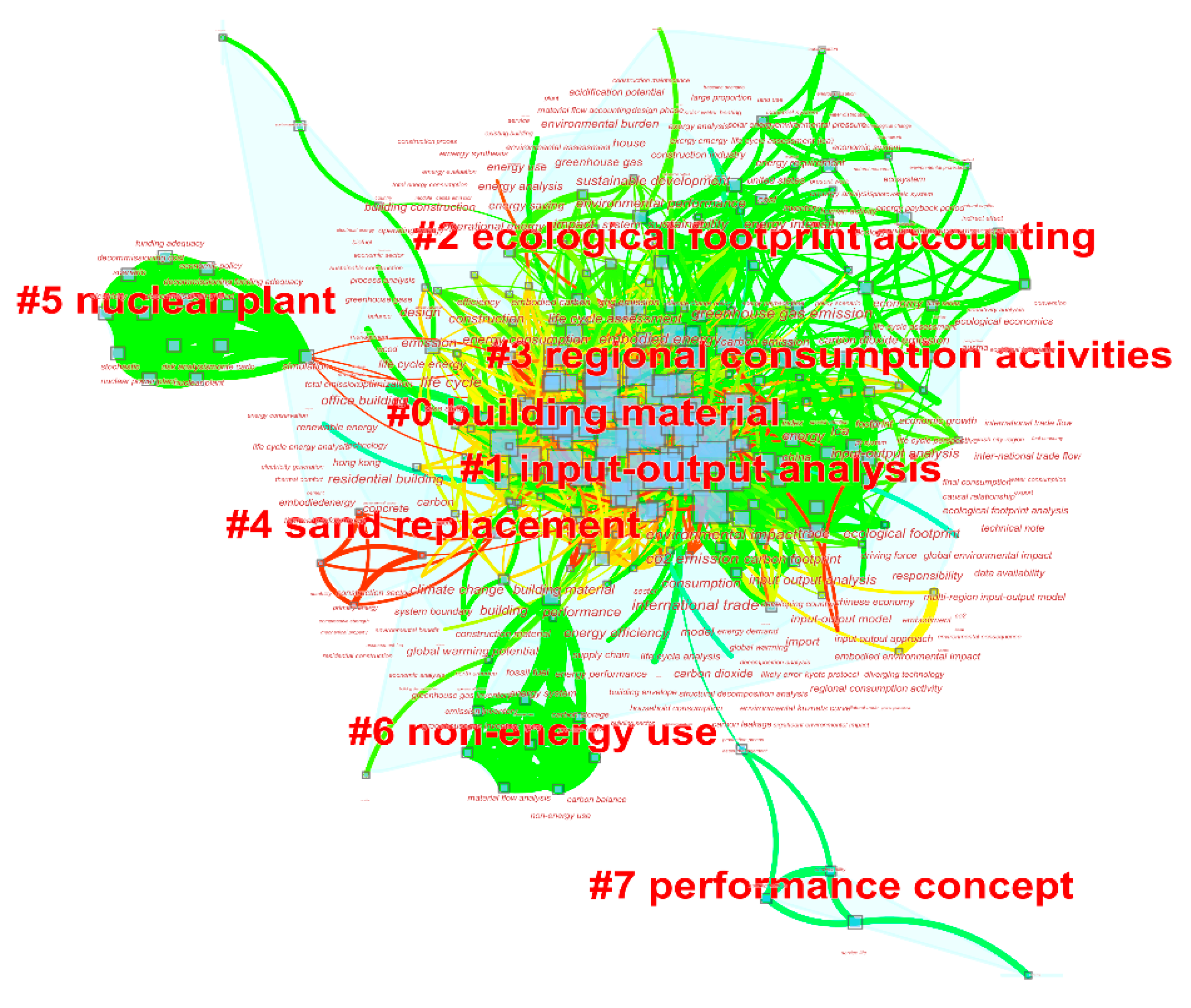
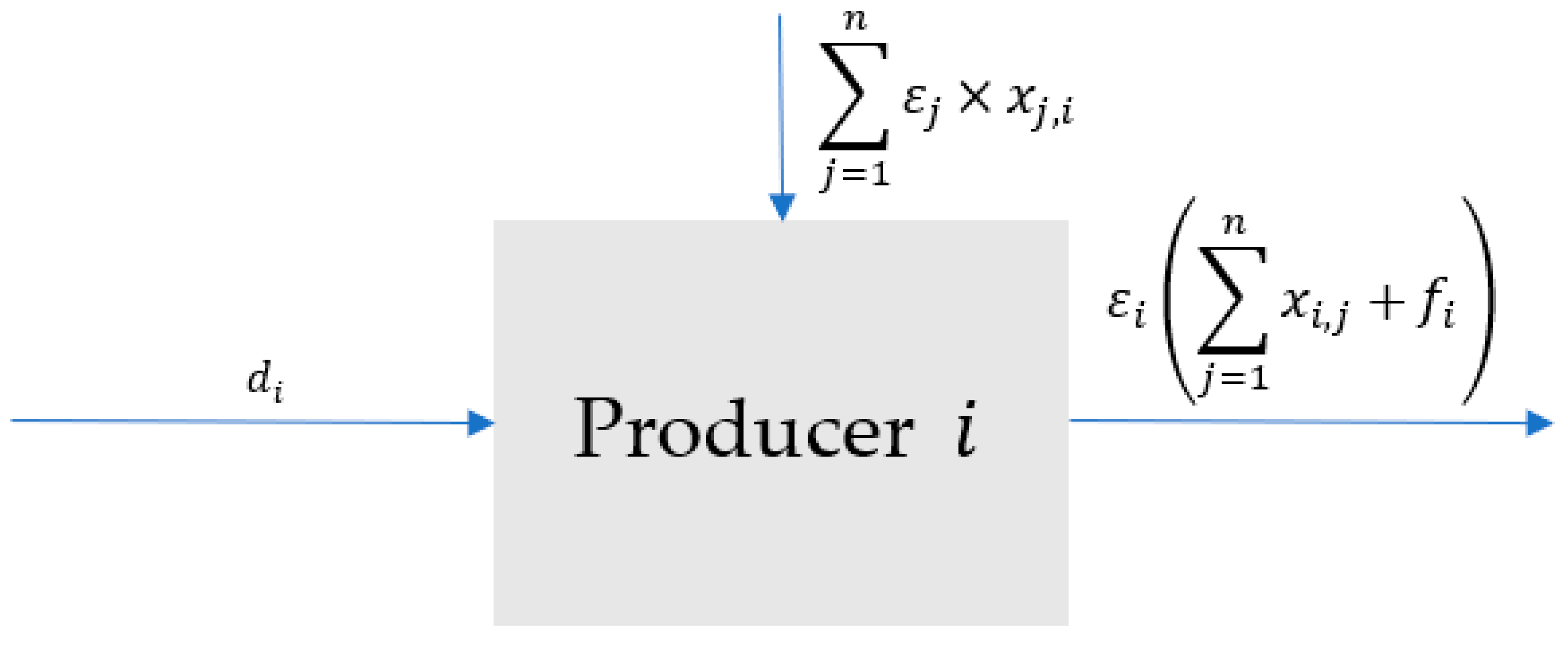
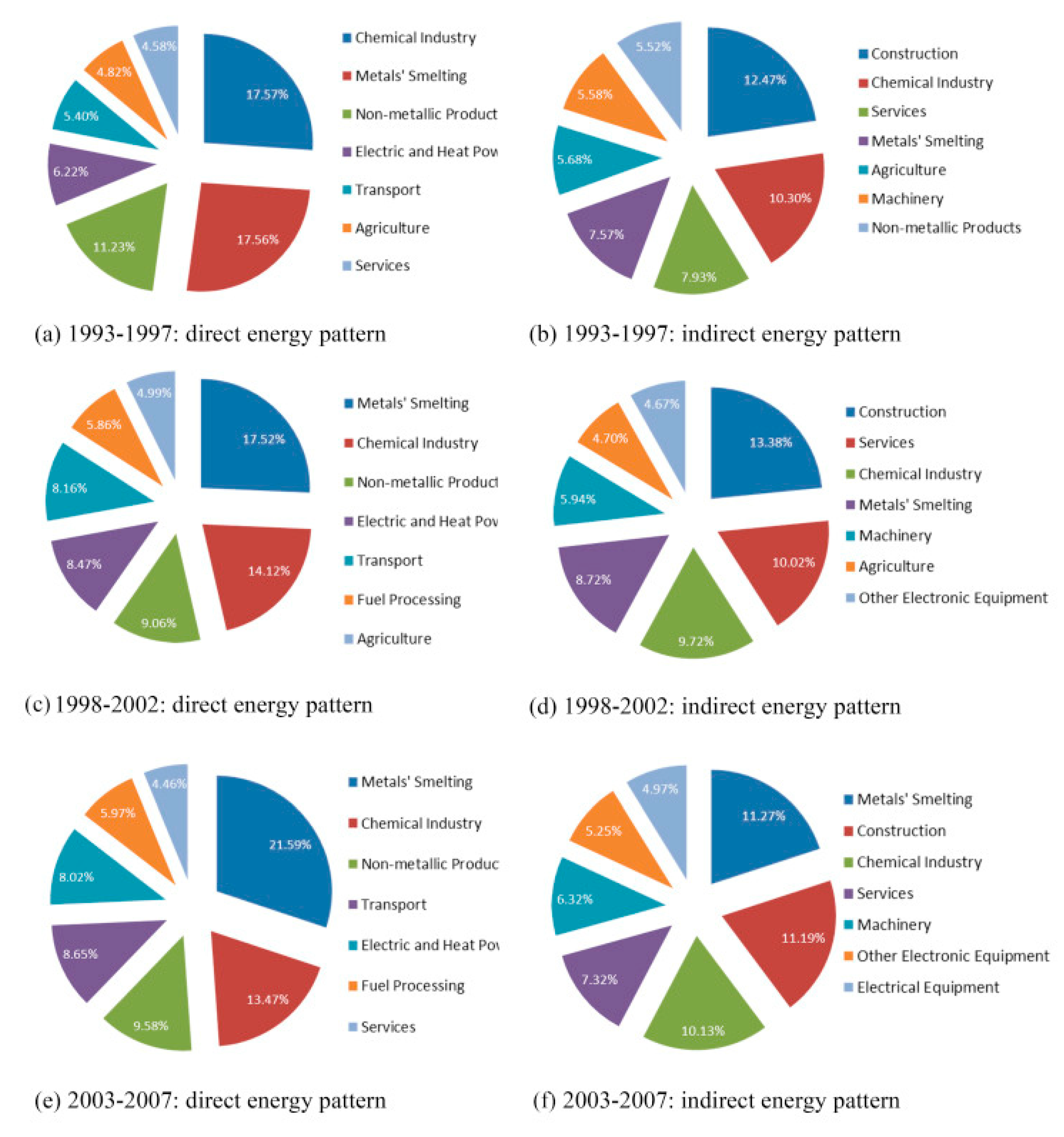
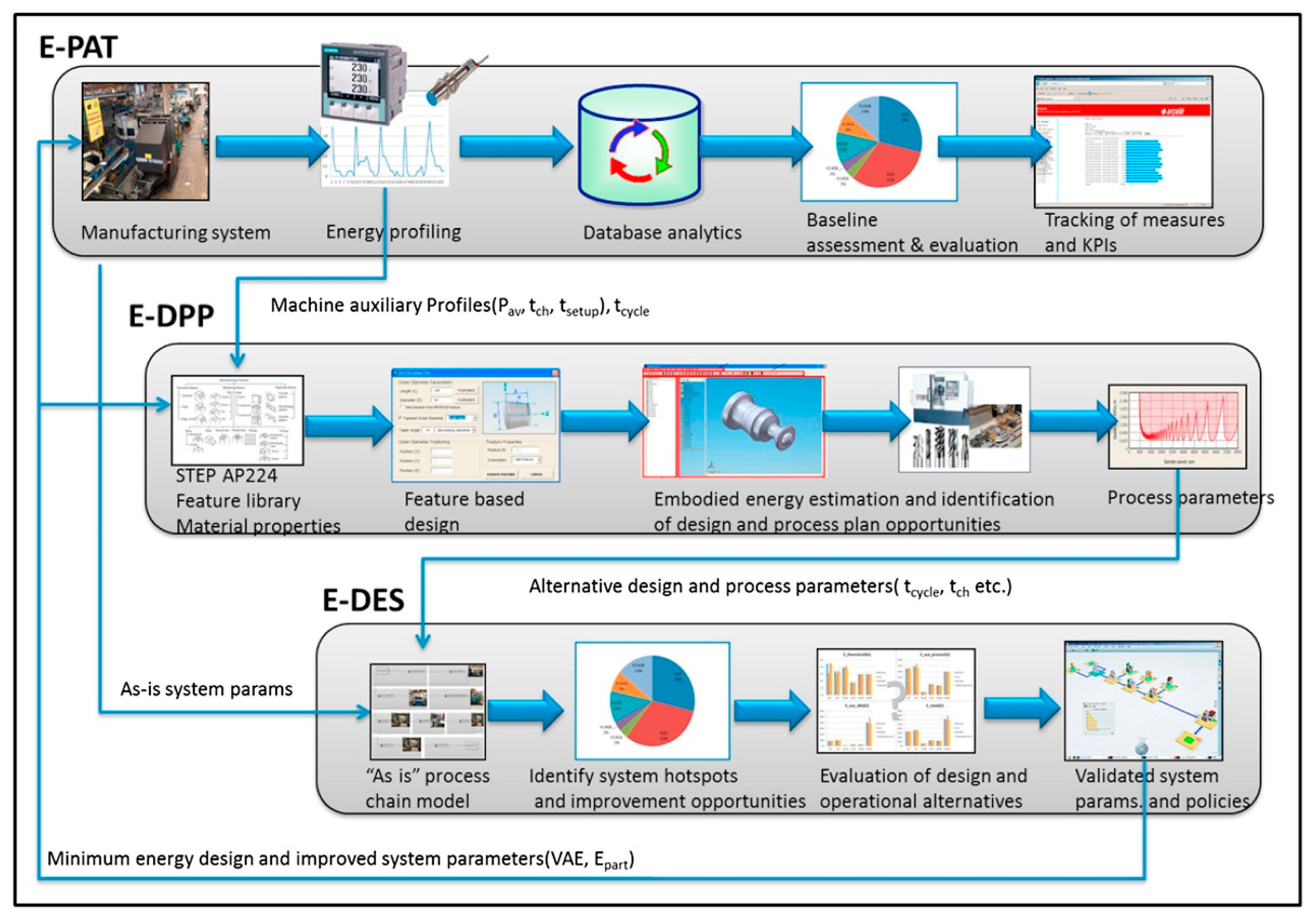
| Journals | Publications | Research Categories |
|---|---|---|
| Journal of Cleaner Production | 211 | Science & Technology—Other Topics; Engineering; Environmental Sciences & Ecology |
| Energy and Buildings | 200 | Construction & Building Technology; Energy & Fuels; Engineering |
| Energy Policy | 118 | Business & Economics; Energy & Fuels; Environmental Sciences & Ecology |
| Applied Energy | 113 | Energy & Fuels; Engineering |
| Building and Environment | 95 | Construction & Building Technology; Engineering |
| Renewable Sustainable Energy Reviews | 87 | Science & Technology—Other Topics Energy & Fuels |
| Environmental Science Technology | 52 | Engineering; Environmental Sciences & Ecology |
| Journal of Industrial Ecology | 43 | Science & Technology—Other Topics; Engineering; Environmental Sciences & Ecology |
| Resources Conservation and Recycling | 41 | Engineering; Environmental Sciences & Ecology |
| Building Research and Information | 36 | Construction & Building Technology |
| No. | Keyword | Freq | No. | Keyword | Freq |
|---|---|---|---|---|---|
| 1 | embodied energy | 761 | 26 | climate change | 104 |
| 2 | life cycle assessment | 454 | 27 | carbon footprint | 100 |
| 3 | energy | 378 | 28 | embodied carbon | 98 |
| 4 | consumption | 310 | 29 | efficiency | 93 |
| 5 | co2 emission | 281 | 30 | input–output analysis | 90 |
| 6 | construction | 236 | 31 | energy efficiency | 89 |
| 7 | international trade | 223 | 32 | concrete | 86 |
| 8 | China | 221 | 33 | trade | 81 |
| 9 | sustainability | 220 | 34 | footprint | 77 |
| 10 | emission | 215 | 35 | sector | 77 |
| 11 | greenhouse gas emission | 213 | 36 | building material | 76 |
| 12 | system | 211 | 37 | life cycle energy | 75 |
| 13 | performance | 201 | 38 | house | 72 |
| 14 | building | 197 | 39 | optimization | 70 |
| 15 | impact | 196 | 40 | cost | 58 |
| 16 | LCA | 167 | 41 | energy use | 56 |
| 17 | environmental impact | 165 | 42 | technology | 51 |
| 18 | input–output analysis | 164 | 43 | office building | 50 |
| 19 | residential building | 159 | 44 | framework | 49 |
| 20 | model | 151 | 45 | simulation | 46 |
| 21 | design | 131 | 46 | inventory | 45 |
| 22 | energy consumption | 130 | 47 | policy | 44 |
| 23 | carbon | 123 | 48 | Embodied energy | 41 |
| 24 | life cycle | 114 | 49 | management | 39 |
| 25 | carbon emission | 109 | 50 | economy | 38 |
| No. | Keywords | No. | Keywords | No. | Keywords |
|---|---|---|---|---|---|
| 1 | waste | 9 | operational energy | 17 | decomposition analysis |
| 2 | transfer | 10 | network | 18 | circular economy |
| 3 | supply chain | 11 | input–output model | 19 | cement |
| 4 | strength | 12 | input output | 20 | built environment |
| 5 | resource | 13 | flow | 21 | assessment lca |
| 6 | requirement | 14 | economic growth | 22 | air pollution |
| 7 | renewable energy | 15 | durability | ||
| 8 | power generation | 16 | driving force |
| Keywords | Year | Strength | Begin | End | 1980–2019 |
|---|---|---|---|---|---|
| sustainability | 1980 | 5.1744 | 1996 | 2007 | ▂▂▂▂▂▂▂▂▂▂▂▂▂▂▂▂▃▃▃▃▃▃▃▃▃▃▃▃▂▂▂▂▂▂▂▂▂▂▂▂ |
| embodied energy | 1980 | 16.9196 | 1997 | 2005 | ▂▂▂▂▂▂▂▂▂▂▂▂▂▂▂▂▂▃▃▃▃▃▃▃▃▃▂▂▂▂▂▂▂▂▂▂▂▂▂▂ |
| import | 1980 | 8.6156 | 1998 | 2010 | ▂▂▂▂▂▂▂▂▂▂▂▂▂▂▂▂▂▂▃▃▃▃▃▃▃▃▃▃▃▃▃▂▂▂▂▂▂▂▂▂ |
| united states | 1980 | 10.8901 | 2001 | 2013 | ▂▂▂▂▂▂▂▂▂▂▂▂▂▂▂▂▂▂▂▂▂▃▃▃▃▃▃▃▃▃▃▃▃▃▂▂▂▂▂▂ |
| sustainable development | 1980 | 6.7481 | 2004 | 2013 | ▂▂▂▂▂▂▂▂▂▂▂▂▂▂▂▂▂▂▂▂▂▂▂▂▃▃▃▃▃▃▃▃▃▃▂▂▂▂▂▂ |
| exergy | 1980 | 8.1758 | 2006 | 2013 | ▂▂▂▂▂▂▂▂▂▂▂▂▂▂▂▂▂▂▂▂▂▂▂▂▂▂▃▃▃▃▃▃▃▃▂▂▂▂▂▂ |
| index | 1980 | 4.5023 | 2007 | 2012 | ▂▂▂▂▂▂▂▂▂▂▂▂▂▂▂▂▂▂▂▂▂▂▂▂▂▂▂▃▃▃▃▃▃▂▂▂▂▂▂▂ |
| input–output approach | 1980 | 5.9576 | 2007 | 2010 | ▂▂▂▂▂▂▂▂▂▂▂▂▂▂▂▂▂▂▂▂▂▂▂▂▂▂▂▃▃▃▃▂▂▂▂▂▂▂▂▂ |
| emergy | 1980 | 5.6802 | 2007 | 2013 | ▂▂▂▂▂▂▂▂▂▂▂▂▂▂▂▂▂▂▂▂▂▂▂▂▂▂▂▃▃▃▃▃▃▃▂▂▂▂▂▂ |
| responsibility | 1980 | 5.1164 | 2007 | 2015 | ▂▂▂▂▂▂▂▂▂▂▂▂▂▂▂▂▂▂▂▂▂▂▂▂▂▂▂▃▃▃▃▃▃▃▃▃▂▂▂▂ |
| ecological footprint | 1980 | 9.1417 | 2007 | 2014 | ▂▂▂▂▂▂▂▂▂▂▂▂▂▂▂▂▂▂▂▂▂▂▂▂▂▂▂▃▃▃▃▃▃▃▃▂▂▂▂▂ |
| emergy analysis | 1980 | 5.2424 | 2007 | 2013 | ▂▂▂▂▂▂▂▂▂▂▂▂▂▂▂▂▂▂▂▂▂▂▂▂▂▂▂▃▃▃▃▃▃▃▂▂▂▂▂▂ |
| wood | 1980 | 8.1945 | 2008 | 2013 | ▂▂▂▂▂▂▂▂▂▂▂▂▂▂▂▂▂▂▂▂▂▂▂▂▂▂▂▂▃▃▃▃▃▃▂▂▂▂▂▂ |
| biomas | 1980 | 4.253 | 2009 | 2012 | ▂▂▂▂▂▂▂▂▂▂▂▂▂▂▂▂▂▂▂▂▂▂▂▂▂▂▂▂▂▃▃▃▃▂▂▂▂▂▂▂ |
| energy analysis | 1980 | 4.253 | 2009 | 2012 | ▂▂▂▂▂▂▂▂▂▂▂▂▂▂▂▂▂▂▂▂▂▂▂▂▂▂▂▂▂▃▃▃▃▂▂▂▂▂▂▂ |
| energy use | 1980 | 7.9758 | 2010 | 2012 | ▂▂▂▂▂▂▂▂▂▂▂▂▂▂▂▂▂▂▂▂▂▂▂▂▂▂▂▂▂▂▃▃▃▂▂▂▂▂▂▂ |
| methodology | 1980 | 5.9936 | 2010 | 2013 | ▂▂▂▂▂▂▂▂▂▂▂▂▂▂▂▂▂▂▂▂▂▂▂▂▂▂▂▂▂▂▃▃▃▃▂▂▂▂▂▂ |
| resources use | 1980 | 4.1693 | 2011 | 2014 | ▂▂▂▂▂▂▂▂▂▂▂▂▂▂▂▂▂▂▂▂▂▂▂▂▂▂▂▂▂▂▂▃▃▃▃▂▂▂▂▂ |
| oil | 1980 | 3.745 | 2011 | 2013 | ▂▂▂▂▂▂▂▂▂▂▂▂▂▂▂▂▂▂▂▂▂▂▂▂▂▂▂▂▂▂▂▃▃▃▂▂▂▂▂▂ |
| environmental assessment | 1980 | 5.3527 | 2011 | 2013 | ▂▂▂▂▂▂▂▂▂▂▂▂▂▂▂▂▂▂▂▂▂▂▂▂▂▂▂▂▂▂▂▃▃▃▂▂▂▂▂▂ |
| environment | 1980 | 5.4648 | 2012 | 2014 | ▂▂▂▂▂▂▂▂▂▂▂▂▂▂▂▂▂▂▂▂▂▂▂▂▂▂▂▂▂▂▂▂▃▃▃▂▂▂▂▂ |
| greenhouse gas | 1980 | 4.0218 | 2012 | 2013 | ▂▂▂▂▂▂▂▂▂▂▂▂▂▂▂▂▂▂▂▂▂▂▂▂▂▂▂▂▂▂▂▂▃▃▂▂▂▂▂▂ |
| cost | 1980 | 4.8938 | 2012 | 2015 | ▂▂▂▂▂▂▂▂▂▂▂▂▂▂▂▂▂▂▂▂▂▂▂▂▂▂▂▂▂▂▂▂▃▃▃▃▂▂▂▂ |
| dwelling | 1980 | 5.2936 | 2012 | 2015 | ▂▂▂▂▂▂▂▂▂▂▂▂▂▂▂▂▂▂▂▂▂▂▂▂▂▂▂▂▂▂▂▂▃▃▃▃▂▂▂▂ |
| environmental performance | 1980 | 5.3633 | 2012 | 2016 | ▂▂▂▂▂▂▂▂▂▂▂▂▂▂▂▂▂▂▂▂▂▂▂▂▂▂▂▂▂▂▂▂▃▃▃▃▃▂▂▂ |
| climate | 1980 | 4.0194 | 2012 | 2016 | ▂▂▂▂▂▂▂▂▂▂▂▂▂▂▂▂▂▂▂▂▂▂▂▂▂▂▂▂▂▂▂▂▃▃▃▃▃▂▂▂ |
| renewable energy | 1980 | 6.2598 | 2013 | 2015 | ▂▂▂▂▂▂▂▂▂▂▂▂▂▂▂▂▂▂▂▂▂▂▂▂▂▂▂▂▂▂▂▂▂▃▃▃▂▂▂▂ |
| requirement | 1980 | 3.9291 | 2013 | 2014 | ▂▂▂▂▂▂▂▂▂▂▂▂▂▂▂▂▂▂▂▂▂▂▂▂▂▂▂▂▂▂▂▂▂▃▃▂▂▂▂▂ |
| need | 1980 | 6.1473 | 2013 | 2014 | ▂▂▂▂▂▂▂▂▂▂▂▂▂▂▂▂▂▂▂▂▂▂▂▂▂▂▂▂▂▂▂▂▂▃▃▂▂▂▂▂ |
| greenhouse gas | 1980 | 4.4685 | 2013 | 2014 | ▂▂▂▂▂▂▂▂▂▂▂▂▂▂▂▂▂▂▂▂▂▂▂▂▂▂▂▂▂▂▂▂▂▃▃▂▂▂▂▂ |
| aggregation | 1980 | 3.9093 | 2013 | 2014 | ▂▂▂▂▂▂▂▂▂▂▂▂▂▂▂▂▂▂▂▂▂▂▂▂▂▂▂▂▂▂▂▂▂▃▃▂▂▂▂▂ |
| embodied emission | 1980 | 4.4425 | 2015 | 2019 | ▂▂▂▂▂▂▂▂▂▂▂▂▂▂▂▂▂▂▂▂▂▂▂▂▂▂▂▂▂▂▂▂▂▂▂▃▃▃▃▃ |
| perspective | 1980 | 5.2075 | 2016 | 2017 | ▂▂▂▂▂▂▂▂▂▂▂▂▂▂▂▂▂▂▂▂▂▂▂▂▂▂▂▂▂▂▂▂▂▂▂▂▃▃▂▂ |
| structural decomposition analysis | 1980 | 7.881 | 2017 | 2019 | ▂▂▂▂▂▂▂▂▂▂▂▂▂▂▂▂▂▂▂▂▂▂▂▂▂▂▂▂▂▂▂▂▂▂▂▂▂▃▃▃ |
| Author | Year | Study Target | Key Results |
|---|---|---|---|
| An et al. [15] | 2015 | Chinese Industries | The basic network features change little during the research period; industries that have most embodied energy flows change from oil-related industries to coal-related industries. |
| Shi et al. [22] | 2017 | global sectors | 80% of flows are between different countries; the network is sensitive; The network presents an obvious clustering feature. |
| Chen et al. [17] | 2018 | Global | At the global level, small-world nature has been found; the economies are highly connected through embodied energy transfer. |
| Gao et al. [57] | 2018 | Interprovincial in China | Heterogeneity distribution of different types of energy flow. |
| Wang et al. [62] | 2019 | Global and China embodied rare earths | World embodied rare earths link network is clearly divided into two communities, and the network can reveal the small world nature characteristics; China, Germany, and the USA are the three most important economies. |
| Jiang et al. [63] | 2018 | The global embodied mineral flow between industrial sectors | There is significant small-world property in the global embodied mineral flow network; other Non-Metallic Mineral in China is the most important consumer of embodied minerals; the embodied mineral flows have strong directionality. |
| Tang et al. [64] | 2019 | Regional and sectoral energy network of China | Sectoral investigation indicates that infrastructure construction remained dominant in the current Chinese economy. |
| Sun et al. [33] | 2016 | Sectors in China | The small world nature identified key sectors of IEFNs (indirect energy flow networks; |
| Feng et al. [65] | 2019 | Internal and external industries of manufacturing in China | most of the embodied energy convergence and transmission is concentrated in a few industries; preferential selections is an important mechanism; the embodied energy flow patterns of the internal network of manufacturing mainly include two-focus and multi-focus convergence patterns. |
| Metrics/KPIs | Unit | Description |
|---|---|---|
| Power | kW | Instant power load |
| Energy | kWh, kJ | Energy consumed in a specific time period |
| Process energy | kWh, kJ | Total energy consumed by a process in a specific time period |
| Theoretical energy | kWh, kJ | Energy consumed only by manufacturing processes in a specific time period |
| Auxiliary energy | kWh, kJ | Energy consumed by subsystems of a machine tool in a specific time period |
| Indirect energy | kWh, kJ | Allocated energy consumed by services used to maintain the environment for production activities such as heating, lighting, etc. |
| Handling energy | kWh, kJ | Energy consumed by transportation equipment such as robots, conveyors, etc. Energy |
| Feature energy | kWh, kJ | Energy used to manufacture a feature |
| Embodied energy | kWh, kJ | Energy used to manufacture a part |
| Energy cost | Currency | The monetary cost of energy used for a specific time period |
| Value-added energy (VAE) per machine | % | Energy consumed by a machine during actual process activities as a percentage of all activities, including idling |
| Value-added energy (VAE) per part | % | Energy consumed by a part during all actual process activities as a percentage of all activities, including waiting, handling, and indirect shares |
© 2019 by the authors. Licensee MDPI, Basel, Switzerland. This article is an open access article distributed under the terms and conditions of the Creative Commons Attribution (CC BY) license (http://creativecommons.org/licenses/by/4.0/).
Share and Cite
Chen, J.; Zhou, W.; Yang, H. Is Embodied Energy a Better Starting Point for Solving Energy Security Issues?—Based on an Overview of Embodied Energy-Related Research. Sustainability 2019, 11, 4260. https://doi.org/10.3390/su11164260
Chen J, Zhou W, Yang H. Is Embodied Energy a Better Starting Point for Solving Energy Security Issues?—Based on an Overview of Embodied Energy-Related Research. Sustainability. 2019; 11(16):4260. https://doi.org/10.3390/su11164260
Chicago/Turabian StyleChen, Jinghan, Wen Zhou, and Hongtao Yang. 2019. "Is Embodied Energy a Better Starting Point for Solving Energy Security Issues?—Based on an Overview of Embodied Energy-Related Research" Sustainability 11, no. 16: 4260. https://doi.org/10.3390/su11164260
APA StyleChen, J., Zhou, W., & Yang, H. (2019). Is Embodied Energy a Better Starting Point for Solving Energy Security Issues?—Based on an Overview of Embodied Energy-Related Research. Sustainability, 11(16), 4260. https://doi.org/10.3390/su11164260





